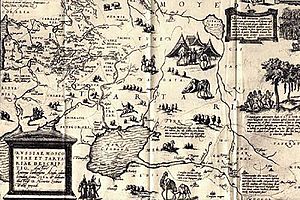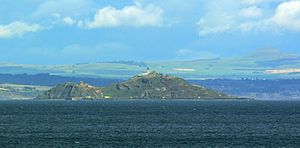Anthony Jenkinson facts for kids
Anthony Jenkinson (1529 – 1610/1611) was an English explorer. He was born in Market Harborough, Leicestershire. He was one of the first Englishmen to explore Muscovy (old Russia) and present-day Russia. Jenkinson traveled and explored for the Muscovy Company and the English crown. He met Ivan the Terrible, the Russian ruler, several times during his trips to Moscow and Russia. He wrote detailed stories about his travels throughout his life.
Contents
Who Was Anthony Jenkinson?
His Early Life and Family
Anthony Jenkinson's father, William Jenkinson, was a wealthy man. Because of this, Anthony was trained from a young age for a career in business and trade. By 1568, Jenkinson had become a very important person for the Muscovy Company.
On January 26, 1568, Jenkinson married Judith Marshe. Her father, John Marshe, had many business connections and was one of the people who started the Muscovy Company. Jenkinson gained a lot from these family business ties. Jenkinson and his wife had eleven children, but only five of them lived to be adults.
By 1606, Jenkinson was living in a large house in Ashton. His wife died before him from a serious illness. Jenkinson was buried on February 16, 1611, at Holy Trinity Church in Teigh, Rutland.
Anthony's son, Sir Robert, was the father of the first of the Jenkinson Baronets of Hawkesbury, Gloucestershire.
Journeys to Russia

Jenkinson traveled to Russia many times for the Muscovy Company. After Richard Chancellor helped set up official trade between Russia and England, Anthony Jenkinson became the first English Ambassador to Russia in 1566. He sailed from London, England, to Russia near the Dvina River. He was on a ship called the Primrose, leading a group of four ships.
First Big Trip (1558)
Jenkinson was in Moscow in 1558. He started his journey by traveling south down the Oka and Volga Rivers. He passed through areas like the Khanate of Kazan and Astrakhan, which Russia had recently taken over. His group continued their journey southeast after crossing the Caspian Sea to Serachik. There, they joined a group of merchants and traveled for several months across the lands of the Nogai Horde, a group of Tatars.
They reached Bukhara after fighting off bandits in the desert. However, they found that the routes to China and India were blocked by wars and bandits. The local leaders were not friendly, so they had to go back the way they came. They left Bukhara just before an army arrived to attack it. After many more difficulties, they arrived back in Moscow in 1559. They could not travel back to England until the sea routes opened in the spring of 1560.
On this journey, Jenkinson made a map of some Russian and Tatar lands. He mistakenly thought the Aral Sea was part of the Caspian Sea. His map was later included in Abraham Ortelius' famous atlas, Theatrum orbis terrarum.
Meeting Ippolyta
Jenkinson brought a young woman or child from Russia to England. She joined the court of Queen Elizabeth. She became known as "Ippolyta the Tartarian". She was given fancy clothes and some of the queen's old clothes.
Second Big Trip (1561)
After his first trip to Russia, Jenkinson quickly got ready for a second one. He planned to travel to Russia and then continue to Persia. He arrived in Moscow in August 1561, hoping to discuss trade deals with Ivan the Terrible. However, he could not meet Ivan until March 1562.
From Moscow, Jenkinson traveled across Russia, down the Caspian Sea, and into Persia. He reached the court of Shah Tahmasp and managed to get special trading deals for the Muscovy Company. However, he found that the bigger goal of trading in the Indian Ocean was blocked by a Portuguese trading post at Ormuz. Also, selling English goods was hard because of competition from traders from Venice.
During this trip, Jenkinson made a great impression on Ivan the Terrible. Ivan gave the Muscovy Company many more trading rights. Jenkinson also helped the Tsar by buying goods for him. In return, Ivan's official letters of support helped Jenkinson a lot with local leaders. In July 1564, Jenkinson returned to London.
Helping in Scotland (1565)

In 1565, Jenkinson was sent on a ship called the Ayde to Scotland during a political crisis. He sailed into the Firth of Forth on September 25, 1565. Jenkinson's job was to stop ships from entering Leith to prevent weapons from France reaching Mary, Queen of Scots. A bad wind brought his ship close to the cannons of the fort on Inchkeith Island.
Jenkinson was told not to say he was sent by the English government. He told the Scottish leaders he was looking for pirates. Queen Mary sent him a gift for Queen Elizabeth and a gold chain for him. He then sailed back to Berwick-upon-Tweed.
In October 1565, Jenkinson captured a ship near Dunbar. This ruined a plan by an English diplomat. Jenkinson's actions led to an argument with the Earl of Bedford, who was England's main diplomat in Scotland.
Third Big Trip (1566)
Jenkinson was sent to Russia for a third time to fix a problem with the trade deals England had made in 1564. When he arrived, he wrote a letter to a friend, mentioning the harsh rule that Ivan had brought to Russia. To successfully negotiate the trade terms, Jenkinson was sent back to England. He was ordered to bring military experts to Russia to help Ivan with his wars. Because of this trip, Jenkinson successfully agreed to new trade terms with the Russian ruler in September 1567.
Final Trip (1571)
In July 1571, Jenkinson went to Russia for his fourth and final trip. In 1568, Ivan had cancelled the special trading rights Jenkinson had gotten in 1566. On behalf of Queen Elizabeth I, Jenkinson was sent to get the trade agreement back. After being delayed at Kholmogory for six months because of an illness, Jenkinson finally arrived in Moscow by May 1572. During his journey, Jenkinson noted the damage that the Crimean Tatars had caused in parts of the country. By July 23, Jenkinson had successfully gotten all trading rights back with Ivan and Russia.
What He Wrote
Jenkinson's maps of Russia were included in Ortelius' famous atlas, Theatrum orbis terrarum. Historians have also studied many of Jenkinson's personal letters that still exist, in which he describes Russia. He especially mentions Ivan's harsh and cruel way of ruling. Also, Jenkinson's travel stories were used in Richard Hakluyt's collection of geographic, trade, and exploration material called The Principal Navigations, Voyages, Traffiques and Discoveries of the English Nation.
See also
 In Spanish: Anthony Jenkinson para niños
In Spanish: Anthony Jenkinson para niños



